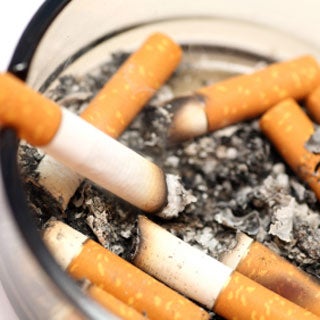2 The main place where young children are exposed to secondhand smoke is at home. Radioactive elements such as polonium-210 see below Benzene.
A sticky black substance in tobacco smoke that coats the inside of the airways and contains many carcinogens.

Tobacco smoke contains what form of cyanide. Toxic effects of tobacco smoke. Chemicals as secondhand tobacco smoke. Tobacco is full of dangerous components that pose serious impacts on human beings of all ages.
Hydrogen cyanide is most well known as a poison used as a gassing agent in World War Two called Zyklon B. It not only affect smokers but also harmful for nonsmokers. Acetaldehyde ammonia arsenic benzene cadmium chromium formaldehyde hydrogen cyanide isoprene lead mercury nickel and quinolinei Marijuana smoke contains tetrahydrocannabinol THC the active chemical in cannabis.
However this reaction occurs too. Is described as having a bitter almond smell but it does not always give. The scientists found that ammonia levels were 20 times higher in the marijuana smoke than in the tobacco smoke while hydrogen cyanide nitric oxide and certain aromatic amines occurred at levels.
Off an odor and not everyone can detect this odor. When present in air it is usually in the form of gaseous hydrogen cyanide. The concentration of cyanide in blood of smokers who had refrained from smoking for at least 2 h.
However in most cases it is bound up in other substances and therefore is harmless to humans. Phases of Tobacco Smoke. Tar A gas that blocks oxygen from getting into the bloodstream.
The scientists found that ammonia levels were 20 times higher in the marijuana smoke than in the tobacco smoke while hydrogen cyanide nitric oxide and certain aromatic amines occurred at levels. Gas such as hydrogen cyanide HCN or cyanogen chloride CNCl or a crystal. Hydrogen cyanide HCN is a primordial molecule on Earth and is present in basically everything on the planet.
The small quantities of cyanide present in dietary sources and in cigarette smoke are normally metabolized to relatively harmless thiocyanate by the mitochondrial enzyme rhodanese thiosulfate cyanide sulfurtransferase which uses thiosulfate as a substrate. The evidence for sodium thiosulfates use is based on animal studies and case reports. 12 Children who are exposed to secondhand tobacco smoke breathe the same dangerous chemicals that smokers inhale.
When tobacco is burned the natural HCN in it is released in the smoke. Cigarettes contain a poisonous gas called _____ which interferes with the ability of blood cells to carry oxygen. Common sources of cyanide poisoning include smoke inhalation from fires industries that use cyanide photography chemical research synthetic plastics metal processing and electroplating.
Of the more than 7000 chemicals in tobacco smoke at least 250 are known to be harmful including hydrogen cyanide carbon monoxide and ammonia 1 2 5. Tobacco-specific nitrosamines TSNAs Polycyclic aromatic hydrocarbons PAHs. Using the sensitive fluorimetric method described here we evaluated the determination of blood cyanide as a method for monitoring exposure to tobacco smoke.
Cyanide compounds that can be poisonous include hydrogen cyanide gas and the crystalline solids potassium cyanide and sodium cyanide. This particular chemical is both harmful to the smoker and to those who may inhale the second hand smoke that is present in the air. Hydrogen cyanide is a poisonous colorless gas that was once used in World War II as a genocidal weapon.
Nicotine the addictive drug that produces the effects in the brain that people are looking for Hydrogen cyanide. Secondhand smoke contains a number of poisonous gases and chemicals including hydrogen cyanide used in chemical weapons carbon monoxide found in car exhaust butane used in lighter fluid ammonia used in household. Carbon monoxide Smokeless tobacco users can develop ___________ a condition characterized by white leathery spots inside the mouth.
Cyanide is also known. Tobacco smoke contains many chemicals that are harmful to both smokers and nonsmokers. Physical Science Hydrogen cyanide is one of hundreds of chemicals found in the smoke of cigarettes.
Naturally no one would want to breathe hydrogen cyanide but smokers do it on a daily basis. Tobacco smoke contains thousands of toxic materials and only a few of them are known today that are causing diseases of vital human body organs. Hydrogen cyanide and carbon monoxide are among these by-products found in cigarette smoke.
Smoke from a burning cigarette is a concentrated aerosol of liquid particles suspended in an atmosphere consisting mainly of nitrogen oxygen carbon monoxide and carbon dioxide Guerin 1980 p. 13 Smoke-free home and vehicle rules help protect children and adults. 201Researchers have also described cigarette smoke as a lightly charged highly concentrated matrix of submicron particles contained in a gas with.
The mean concentration of cyanide in blood from eight nonsmokers was 0098 SD 0036 mumolL. Some of the known carcinogens or toxi ns present in marijuana smoke include. Form such as sodium cyanide NaCN or potassium cyanide KCN.
Tobacco smoke hurts babies and children. Smoking cigarettes is probably one of the major sources of cyanide exposure for people who do not work in cyanide-related industries. Breathing even a little tobacco smoke can be harmful 1-4.
Some of the chemicals found in tobacco smoke include.
